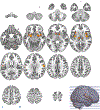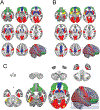Hunger and BMI modulate neural responses to sweet stimuli: fMRI meta-analysis
- PMID: 32555497
- PMCID: PMC8023765
- DOI: 10.1038/s41366-020-0608-5
Hunger and BMI modulate neural responses to sweet stimuli: fMRI meta-analysis
Abstract
Objective: Consuming sweet foods, even when sated, can lead to unwanted weight gain. Contextual factors, such as longer time fasting, subjective hunger, and body mass index (BMI), may increase the likelihood of overeating. Nevertheless, the neural mechanisms underlying these moderating influences on energy intake are poorly understood.
Methods: We conducted both categorical meta-analysis and meta-regression of factors modulating neural responses to sweet stimuli, using data from 30 functional magnetic resonance imaging (fMRI) articles incorporating 39 experiments (N = 995) carried out between 2006 and 2019.
Results: Responses to sweet stimuli were associated with increased activity in regions associated with taste, sensory integration, and reward processing. These taste-evoked responses were modulated by context. Longer fasts were associated with higher posterior cerebellar, thalamic, and striatal activity. Greater self-reported hunger was associated with higher medial orbitofrontal cortex (OFC), dorsal striatum, and amygdala activity and lower posterior cerebellar activity. Higher BMI was associated with higher posterior cerebellar and insular activity.
Conclusions: Variations in fasting time, self-reported hunger, and BMI are contexts associated with differential sweet stimulus responses in regions associated with reward processing and homeostatic regulation. These results are broadly consistent with a hierarchical model of taste processing. Hunger, but not fasting or BMI, was associated with sweet stimulus-related OFC activity. Our findings extend existing models of taste processing to include posterior cerebellar regions that are associated with moderating effects of both state (fast length and self-reported hunger) and trait (BMI) variables.
Conflict of interest statement
Figures




References
Publication types
MeSH terms
Substances
Grants and funding
LinkOut - more resources
Full Text Sources

